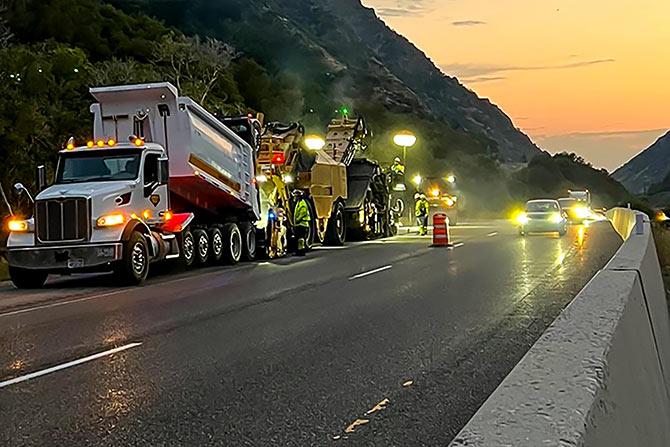Project Start: July 2024
Project Completion: August 2024
Owner: Utah Department of Transportation, Region 1
General Contractor:
Geneva Rock Products Inc.
Daniel Bird, Project Manager
Project Value: $1,895,000
Key Project Team Members:
Lincoln Port, PE, UDOT Project Manager
Steve Niebergall, PE (Sunrise Engineering), UDOT Resident Engineer
Joe Gertge, GRP Foreman
Brian Lunda, GRP Superintendent
Project Overview
The I-84; U.S.-89 to SR-167 Highway Improvement Project stands as a critical enhancement to the safety and functionality of one of Utah’s more dangerous freeway corridors. This $1.89 million project, commissioned by the Utah Department of Transportation (UDOT), Region 1, involved the resurfacing of 225,000 square yards of Bonded Wearing Course Type B; 38,000 square yards of variable-depth milling; the installation of new, high-visibility striping; and project signage.
Despite facing the challenges of high traffic volumes, dangerous blind curves and minimal shoulders constrained by concrete barriers, the project was completed two weeks ahead of schedule with superior craftsmanship and attention to safety.
Safety
The freeway featured sharp turning radiuses, high-speed cars and commercial freight carriers, and limited shoulders — making it particularly hazardous for drivers and construction workers alike. The project introduced contrasting epoxy pavement markings and high-visibility pavement marking tape on the newly paved Bonded Wearing Course (BWC), ensuring improved visibility during night driving and in adverse weather conditions.
Moreover, the 1-inch BWC surface provides superior skid resistance, further enhancing safety, particularly along the blind curves where loss of vehicle control is a higher risk. Where previously the pavement markings were not visible during inclement weather, the project’s focus on installing long-lasting reflective epoxy pavement markings has greatly improved lane delineation, guiding drivers safely through challenging sections of the freeway.
Overcoming Challenges and Teamwork
With high traffic volumes, particularly from commercial freight carriers and dangerous blind curves, maintaining traffic flow while ensuring the safety of workers required careful planning and execution. The location and distance of each shift of paving were coordinated with UDOT traffic and safety, the asphalt hot plant, the traffic control crew and the Utah Highway Patrol to ensure the schedule was met with zero recordable or near-miss incidents.
The construction team implemented a phased construction schedule during off-peak hours to minimize traffic disruption and protect both workers and the traveling public during higher traffic volumes. The project required swift coordination between UDOT, contractors and local stakeholders to manage lane closures and detours while keeping the project timeline on track.
Innovation and Contribution to the Industry/Community
The I-84 project utilized innovative techniques, particularly with the use of BWC Type B, a high-performance overlay designed to extend the pavement’s life and provide enhanced durability. The asphalt material consists of ½-inch HMA with performance grade oil (PG 64-34) and a polymer modified emulsion material (PMEM) placed with a spray paver. The spray paver differs tremendously from a conventional highway paver and consists of many moving parts and niche controls that require a full-time mechanic during any shift of paving. The project delivered a surface that resists cracking and rutting and is essential for a high-traffic area prone to extreme temperature variations.
In addition to BWC pavement innovations, the installation of contrasting epoxy pavement markings is a cutting-edge safety measure that improves visibility, especially at night or during adverse conditions.
Construction Quality and Craftsmanship
The milling process was critical for removing stressed pavement and providing a 1-inch tie-in point at the cast in place barrier locations. This ensured a seamless bond between the old and new pavement, preventing early failures and ensuring a smooth driving experience for motorists. The team paved all asphalt within the dedicated temperature range of 60 degrees and rising at night for the BWC, and per UDOT standards for signage and striping.
Function and Aesthetic
Before the project started, there was one rough location in particular that needed to be addressed; the westbound structure over the Weber River created a severe bump and was a continual nuisance to UDOT maintenance. This transition was addressed by removing the surfacing of the bridge deck and approach and grinding a new transition to the pavement. It was re-emulsified to create a smoother ride from bridge to pavement. Aesthetically, the project enhances the freeway’s visual appeal, particularly with the clean, uniform surface of the BWC and the bright, clear epoxy markings.







